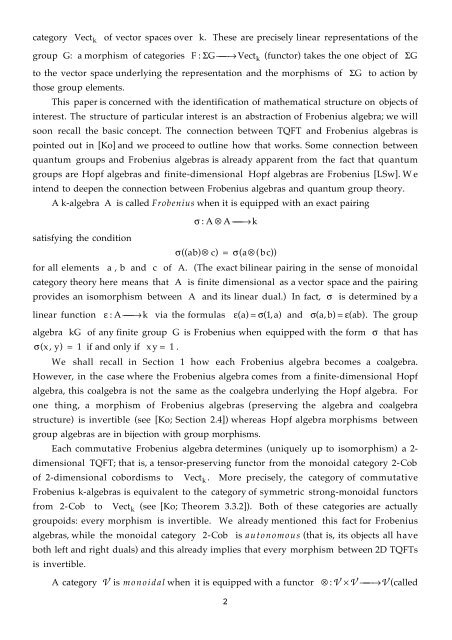Frobenius monads and pseudomonoids Introduction - ResearchGate
Frobenius monads and pseudomonoids Introduction - ResearchGate
Frobenius monads and pseudomonoids Introduction - ResearchGate
You also want an ePaper? Increase the reach of your titles
YUMPU automatically turns print PDFs into web optimized ePapers that Google loves.
category Vect k of vector spaces over k. These are precisely linear representations of the<br />
group G: a morphism of categories F: SG æ ÆVectk<br />
(functor) takes the one object of SG<br />
to the vector space underlying the representation <strong>and</strong> the morphisms of SG to action by<br />
those group elements.<br />
This paper is concerned with the identification of mathematical structure on objects of<br />
interest. The structure of particular interest is an abstraction of <strong>Frobenius</strong> algebra; we will<br />
soon recall the basic concept. The connection between TQFT <strong>and</strong> <strong>Frobenius</strong> algebras is<br />
pointed out in [Ko] <strong>and</strong> we proceed to outline how that works. Some connection between<br />
quantum groups <strong>and</strong> <strong>Frobenius</strong> algebras is already apparent from the fact that quantum<br />
groups are Hopf algebras <strong>and</strong> finite-dimensional Hopf algebras are <strong>Frobenius</strong> [LSw]. W e<br />
intend to deepen the connection between <strong>Frobenius</strong> algebras <strong>and</strong> quantum group theory.<br />
A k-algebra A is called <strong>Frobenius</strong> when it is equipped with an exact pairing<br />
s :AƒAæÆk æ<br />
satisfying the condition<br />
s(( ab) ƒ c) = s(<br />
aƒ( bc))<br />
for all elements a , b <strong>and</strong> c of A. (The exact bilinear pairing in the sense of monoidal<br />
category theory here means that A is finite dimensional as a vector space <strong>and</strong> the pairing<br />
provides an isomorphism between A <strong>and</strong> its linear dual.) In fact, s is determined by a<br />
linear function e :AæÆ æ k via the formulas e( a) = s(<br />
1, a)<br />
<strong>and</strong> s( ab , ) = e(<br />
ab)<br />
. The group<br />
algebra kG of any finite group G is <strong>Frobenius</strong> when equipped with the form s that has<br />
s( x, y ) = 1 if <strong>and</strong> only if xy = 1.<br />
We shall recall in Section 1 how each <strong>Frobenius</strong> algebra becomes a coalgebra.<br />
However, in the case where the <strong>Frobenius</strong> algebra comes from a finite-dimensional Hopf<br />
algebra, this coalgebra is not the same as the coalgebra underlying the Hopf algebra. For<br />
one thing, a morphism of <strong>Frobenius</strong> algebras (preserving the algebra <strong>and</strong> coalgebra<br />
structure) is invertible (see [Ko; Section 2.4]) whereas Hopf algebra morphisms between<br />
group algebras are in bijection with group morphisms.<br />
Each commutative <strong>Frobenius</strong> algebra determines (uniquely up to isomorphism) a 2dimensional<br />
TQFT; that is, a tensor-preserving functor from the monoidal category 2-Cob<br />
of 2-dimensional cobordisms to Vectk . More precisely, the category of commutative<br />
<strong>Frobenius</strong> k-algebras is equivalent to the category of symmetric strong-monoidal functors<br />
from 2-Cob to Vectk (see [Ko; Theorem 3.3.2]). Both of these categories are actually<br />
groupoids: every morphism is invertible. We already mentioned this fact for <strong>Frobenius</strong><br />
algebras, while the monoidal category 2-Cob is autonomous (that is, its objects all have<br />
both left <strong>and</strong> right duals) <strong>and</strong> this already implies that every morphism between 2D TQFTs<br />
is invertible.<br />
A category V is monoidal when it is equipped with a functor<br />
2<br />
ƒ ¥ æ Æ æ :V V V (called
















